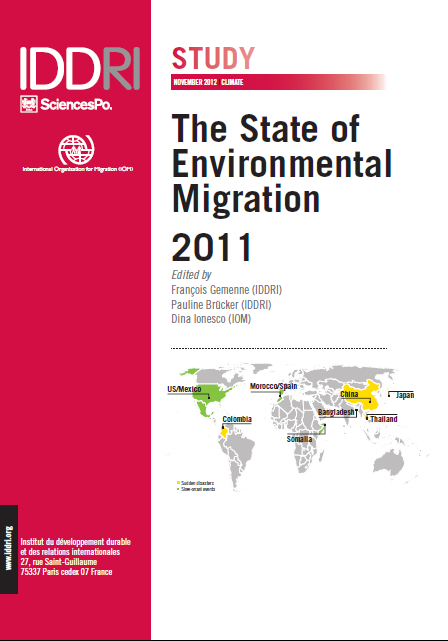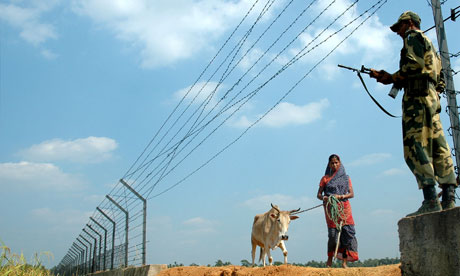Environmental degradation & climate change have induced human mobility by creating environmental migrants. This report presents a qualitative assessment of the most significant situations that took place in 2011 and emphasizes how migration policy can be used as a tool to manage the pressing needs of vulnerable communities to adapt to disparate environmental hazards.

The report by the Institute for Sustainable Development and International Relations (IDDRI), shows the complexity of migration in the context of environmental degradation and climate change. The case study of Bangladeshi migration following the 2001 floods aims at presenting a specific case of environmental migration , considering the particular context of Indo-Bangladeshi relations.
Synopsis of the case study : Floods in Bangladesh and migration to India

Environmental migration from Bangladesh due to heavy floods ( Image:www.leadindianews.com)
This study presents the different aspects of the issue of Bangladeshi flood-induced migrations to India. Floods in 2011 affected more than a million people in Bangladesh directly, forcing people to adapt or to leave and migrate to India. This study shows the complex link between floods and transnational migrations in Bangladesh, analyses the 2011 episode and the political response that emerged, and finally contextualizes Bangladeshi flood-induced migrations to India in order to present the specificities of this international issue.
The main issues discussed are:
- Floods and migration in Bangladesh: A study of patterns

In an average year, 40% of Bangladesh's total land area is flooded ( Image:www.ncnnews.com)
One of the most vulnerable countries in the world, Bangladesh is densely populated, located on a gigantic delta of three rivers. In an average year, 40% of Bangladesh’s total land area is flooded and river erosion washes away 1% of arable land.
The most obvious answer to migration is to assume that the Bangladeshis leave the land that is destroyed by recurrent flooding. Human casualties and economic damages explain the departure to less ecologically-fragile territories
This would confirm the idea that Bangladeshis illegally crossing the Indian border are not only attracted by the opportunities of economic prosperity, but also to escape a situation of great danger for their lives. Floods appear thus as a pertinent answer for this assumption. Migrating becomes a possible response to the brutality of the environmental crisis. Even if floods do not create the migrations per say, they create the conditions for these migrations to develop. They superimpose on social, political and economic factors an environmental crisis that can only strengthen the incentive for departure.
- The 2011 floods

People forced to move after their homes and land was inundated by the 2011 floods ( Image:iddri)
The 2011 floods were not extraordinary in their intensity and the damages they caused, but still hundreds of thousands of people were forced to move. The management of the Ganges-Brahmaputra-Meghna river system was rapidly overcome by the rains, and the dams built upstream put many lives in dangers.
2011 crisis triggered international reactions from both NGOs and international organizations. However, the management of the floods has been criticized for the limited reactivity of authorities. The issue was not a lack of infrastructure, as facilities to gather accurate data exist, but to the weakness of sharing of information at the bilateral level.
The analysis proves that solutions can only emerge with additional action at the national, regional and international levels. Cooperation between the countries of South Asia is particularly fundamental given the influence of transnational rivers in flooding in Bangladesh.
- Contextualization: Bangladeshi environmental migrations to India as a security issue

Environmental migration a security issue for India ( Image:www.guardian.co.uk)
The migration of Bangladeshis is mainly pictured as a threat to internal stability of its neighbouring country, India. It blames Bangladesh for using climate change for political purposes. The instability of the region linked to its terrain, makes any attempt at controlling the border difficult. As a result, illegal Bangladeshi migrations are seen as part of the general context of insecurity.
India’s measure to treat this issue as a security concern began with the construction of fences along the border. Parallel to the very concrete work of fencing the frontier, India put into place patrols and a series of strict policies regarding illegal Bangladeshi migrants. These policies have been at the centre of controversy as they resulted in violence against and even killing of migrants trying to cross the border.
- Conclusion
Flood-induced migrations from Bangladesh to India are a remarkable expression of the complexity of environmental migrations today. The 2011 floods have showed the need for international cooperation and highlighted the need of better management of the issue at the bilateral level.
India cannot afford to reject the management of migrants fleeing the floods to its neighbour, especially considering the looming consequences of global warming on the Bangladeshi territory. That is why the question of environmental migrations here is highly political.
If the crux of the problem remains the long-term reduction of damages due to floods, mid-term responses have to be designed to deal with the increasing number of migrants that continue to suffer from this phenomenon. From this perspective, bilateral cooperation appears as the only solution to an increasingly important issue.
Summary of the complete report
The report on the whole focuses on cross-border displacement and the securitization of migration. It calls attention to environmental migrants by offering insights on climate-related events of the year 2011, their migratory impacts, and the policies and programmes that were developed in response.
The report is divided into 2 distinct parts dealing with case studies that gather and document environmentally-induced migration and displacement that happened during the year 2011, both due to sudden disasters and slow onset.
It compromises of the following sections:
Part 1: Sudden Disasters
Environment and migration: The 2011 floods in Thailand
Temporary and circular labor migration between Spain and Colombia
The 11 March triple disaster in Japan
The 2011 South China floods - drought, three gorges dam and migration
Floods in Bangladesh and migration to India
Part 2: Slow-onset events
Drought in Somalia: A migration crisis
Drought and Mexico-US migration
The model of Almeria: Temporary migration programs as a solution for environmentally-induced migration
To read the complete report click here.